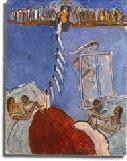SEARCH CurtainUp
On TKTS
LETTERS TO EDITOR
REVIEWS
FEATURES
ADDRESS BOOKS
Broadway
Off-Broadway
DC
NEWS (Etcetera)
BOOKS and CDs
(with Amazon search)
OTHER PLACES
Berkshires
DC (Washington)
London
Los Angeles
QUOTES
FILM
LINKS
MISCELLANEOUS
Free Updates
Masthead
Type too small?
NYC Weather
A CurtainUp Review Charlotte: Life? Or Theater?
by Kathryn Osenlund
 |
The world premiere of Charlotte: Life? Or Theater? at the Prince Music Theater coincides with the exhibit of Charlotte Solomon's paintings at the Jewish Museum in New York. The musical play at the Prince runs until March 18. The exhibit runs until March 25. It would be valuable to complement the viewing of this production with a visit to the museum (see link to their Web Site below).
This is something you don't see every day. Not exactly a play or a musical, it is a piece of non-traditional performance art that is odd and expressionist with its talk, lyrics, posings, musical score and the manipulation of spatial arrangements and lights. However, without her paintings or her musical choices to enlighten the audience, the piece is less about the actual Charlotte and her actual work than it is about a concept and an experience. It is an extremely good production of a somewhat poorly conceived idea -- to do Charlotte without more of the help her art, music, and text would have provided.
Charlotte lived in Germany, then France in bad and interesting times. She documented her life, or rather her family and the people she knew, in over 1,300 gouache paintings. She painted with snatches of various pieces of music in her head, which she noted in writing as the music meant to accompany the work, her "Three-Color Opera." The author and composer have chosen leave out the paintings (until a few are shown at the very end in epilogue fashion) and the specific music (except for the interweaving of a few pieces chosen by Charlotte) in order to focus on Charlotte's life. This is a strange choice when you consider that not much happens in her life, unless you count the numerous suicides in her extended family and the fact that she died at Auschwitz at the age of 26. The one interesting thing about Charlotte's life is her paintings. Her work is the only thing that distinguishes her from countless others who shared her fate.
Charlotte is not front and center in her paintings. Here Charlotte, the observer, is moved to center stage in a theatrical approximation of her life, a place where she is neither at home nor interesting enough to sustain a two hour near-opera. Luckily there are others. Charlotte (played by Mara Stephens) is not the strongest singer, but her considerable attraction lies in her animation in the observer role and her amazing ability to appear 'real' in an artificial and contrived setting. The other actors/singers are all very, very good. And the absolutely incredible voice of Anne Kanengeiser in the role of Paulinka Bimbam helps to sustain the production through the end of the slow first act and throughout the second.
The theater piece seems to begin in earnest with the second act when Charlotte becomes an artist. The stage becomes energized with dramatic lighting and colors. The extremely large space is utilized, with arrangements of figures and exacting choreography of movement. Gary Fagin's emotional and evocative score is a stunning accompaniment to the odd, expressionist action. Much has been written lately of Charlotte's "joy of living," but very little joy is evident in the musical play. The first act is quite somber. The second act, while not joyful, is vibrant.
The actors are posed in various vignettes. Initially weird and ineffective, this choice was made by the author to substitute for Charlotte's painting. It isn't a completely successful trade off. However, these poses become the repeated motif of the performance. The poses do accumulate, and at the end, when a few paintings are projected there is some resonance as the poses are recognized as specific poses in Charlotte's paintings. This would have been a more satisfying experience had the paintings been incorporated and projected earlier and more often in the production so that the audience, many of whom were puzzled according to after-show buzz, could share in where the action was going. In fact, truth be told, it also seems like a good idea to take 35 minutes of Act One and combine that with Act Two to form a 90 minute One-Act musical play without an intermission.
Still, with its truly wonderful exactness, its excellent score, the powerful and moving voice of Kanengeiser, and the folding of all these things into a performance, the work lines up with the Prince Music Theater's mission and dedication " to the future of a great art form, both the oldest and the newest uniting music, text, movement and design to tell great stories," and to "celebrate creative mavericks."
For more about the exhibit, including other copies of art work, go to the Jewish Museum Website
|
Charlotte: Life? Or Theater?
Book and Lyrics by Elise Thoron Music by Gary S. Fagin Directed by Ted Sperling Cast: Mara Stephens, Scott Burkell, Caitlin Clarke, Nancy Hume, Anne Kanengeiser, Larry Keith, Olga Talyn-Pask, William Youmans Scenic Design: Douglas Stein Lighting Design: Jane Cox Musical Direction: Sam Davis Movement: Barney O'Hanlon Costume Design: Kasia Walicka Maimone Sound Design: Nick Kourtides Running time: 2 hours, 5 minutes with one intermission Prince Music Theater, 1412 Chestnut Str., 215.972.1006, www.princemusictheater.org 02/24/01-03/18/01;< opening 0 3/03/01 Reviewed by Kathryn Osenlund based on 03/10 performance |






